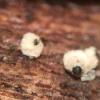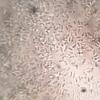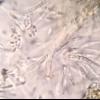
05-11-2019 21:06
Ethan CrensonRecently in a New York City park I came across a f

30-10-2019 05:29
 Stephen Martin
Stephen Martin
Material from Malta. The immature ascocarps consis

04-11-2019 13:07
 Miguel Ángel Ribes
Miguel Ángel Ribes
Hi friendsI have this Penicillium?? growing on a "

04-11-2019 19:17
Stefan BlaserHello everybody, I did have limited possibilities

04-11-2019 12:56
 Miguel Ángel Ribes
Miguel Ángel Ribes
Hi friendsI have this Paecilomyces?? growing on a

02-11-2019 22:25
 Yannick Mourgues
Yannick Mourgues
Bonsoir. Comment qualifier ces spores ? Simpleme
like Lasiosphaeria ovina, but an anamorph
Ethan Crenson,
05-11-2019 21:06
Recently in a New York City park I came across a few small fruiting bodies, tiny (less than 1mm) spheres clad in fine white downy hairs with a smooth black spot. My first thought was Schizoxylon or Lasiosphaeria ovina. Microscopy revealed that it is an anamorph. I don't have much more material to work with, but I was wondering if this looks familiar to anybody.
Thanks in advance.
Ethan



